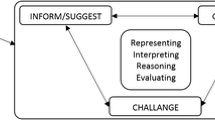Abstract
Student responses to arithmetical questions that can be solved by using arithmetical structure can serve to reveal the extent and nature of relational, as opposed to computational thinking. Student responses to probes which require them to justify-on-demand are analysed using a conceptual framework which highlights distinctions between different forms of attention. We analyse a number of actions observed in students in terms of forms of attention and shifts between them: in the shortterm (the moment), medium-term (over several tasks), and long-term (over a year). The main factors conditioning students_ attention and its movement are identified and some didactical consequences are proposed.
Résumé
Les réponses des étudiants aux questions qui peuvent être résolues par structure arithmétique sont parfois utiles pour déterminer la portée et la nature de la pensée relationnelle, par opposition à la pensée computationnelle. Les réponses des étudiants aux questions qui requièrent une justification sur demande sont analysées au moyen d’un cadre conceptuel qui met en relief les distinctions entre différents niveaux d’attention. Nous analysons certaines actions observées chez des étudiants en termes de niveaux d’attention, ainsi que les passages d’un niveau à l’autre: à court terme (sur le moment), à moyen terme (au cours d’un certain nombre de tâches) et à long terme (sur une année). Les facteurs principaux qui conditionnent l’attention des étudiants et les différents passages d’un niveau l’autre sont identifiés et certaines conséquences didactiques sont proposées.
Similar content being viewed by others
References
Ainley, J., & Pratt, D. (2002). Purpose and utility in pedagogic task design. In A. Cockburn & E. Nardi (Eds.), Proceedings of the 26th annual conference of the International Group for the Psychology of Mathematics Education (Vol. 2, pp. 17–24). Norwich, England: Program Committee.
Becker, J. R., & Rivera, F. D. (2008). Generalization in algebra: The foundation of algebraic thinking and reasoning across the grades. The International Journal on Mathematics Education, 40(1), 1.
Behr, M., Erlwanger, S., & Nichols, E. (1980). How children view the equal sign. Mathematics Teaching, 92, 13–15.
Bezdek, A. (1988). Mathematics for the first classes of academic secondary schools. (I. Hajnal & K. Nemethy, Trans.). Budapest: Tankonyvkiado.
Boero, P. (2001). Transformation and anticipation as key processes in algebraic problem solving. In R. Sutherland (Ed.), Algebraic processes and structures (pp. 99–119). Dordrecht, The Netherlands: Kluwer.
Brousseau, G. (1984). The crucial role of the didactic contract in the analysis and construction of situations in teaching and learning mathematics. In H. G. Steiner (Ed.), Theory of mathematics education (pp. 110–119). Bielefeld, Germany: Institut für Didaktik der Mathematik der Universität Bielefeld.
Carpenter, T. P., Franke, M. L., & Levi, L. (2003). Thinking mathematically: Integrating arithmetic and algebra in elementary school. Portsmouth, England: Heinemann.
Cobb, P., Confrey, J., diSessa, A., Lehrer, R., & Schauble, L. (2003). Design experiment in educational research. Educational Researcher, 32(1), 9–13.
Freudenthal, H. (1978). Weeding and sowing: Preface to a science of mathematics education. Dordrecht, The Netherlands: Reidel.
Fujii, T., & Stephens, M. (2001). Fostering an understanding of algebraic generalisation through numerical expressions: The role of quasi-variables. In H. Chick, K. Stacey, J. Vincent, & J. Vincent (Eds.), Proceedings of the 12th ICMI study conference. The future of the teaching and learning of algebra (pp. 258–264). Melbourne, Australia: University of Melbourne.
Hamilton, E., & Cairns, H. (Eds.). (1961). Plato: The collected dialogues including the letters (W. Guthrie, Trans.). Princeton, NJ: Princeton University Press.
Hejny, M., Jirotkova, D., & Kratochvilova, J. (2006). Early conceptual thinking. In J. Novotná, H. Moraová, M. Krátká, & N. Stehlíková (Eds.), Proceedings of the 30th annual conference of the International Group for the Psychology of Mathematics Education (Vol. 3, pp. 289–296). Prague, Czech Republic: Program Committee.
Hewitt, D. (1998). Approaching arithmetic algebraically. Mathematics Teaching, 163, 19–29.
Hoch, M., & Dreyfus, T. (2004). Structure sense in high school algebra: the effect of brackets. In M. Johnsen & A. Berit (Eds.), Proceedings of the 28th annual conference of the International Group for the Psychology of Mathematics Education (Vol. 3, pp. 49–56). Bergen, Norway: Program Committee.
Kaput, J., Carraher, D. W., & Blanton, M. L. (2007). Algebra in the early grades. New York: Lawrence Erlbaum.
Kelly, A. E., & Lesh, R. A. (2000). Handbook of research design in mathematics and science education. New Jersey: Lawrence Erlbaum Associates.
Kieran, C. (1981). Concepts associated with the equality symbol. Educational Studies in Mathematics, 12(3), 317–326.
Kilpatrick, J., Swafford, J., & Findell, B. (Eds.). (2001). Adding it up: Helping children learn mathematics. Washington, DC: National Academies Press.
Knuth, E. J., Alibali, M. W., McNeil, N. M., Weinberg, A., & Stephens, A. C. (2005). Middle school students’ understanding of core algebraic concepts: Equivalence and variable. The International Journal on Mathematics Education, 37(1), 68–76.
Martino, A. M., & Maher, C. A. (1999). Teachers question to promote justification and generalization in mathematics: What research practice has taught us. The Journal of Mathematical Behavior, 18(1), 53–78.
Marton, F., & Booth, S. (1997). Learning and awareness. Mahwah, NJ: Lawrence Erlbaum.
Mason, J. (1998). Enabling teachers to be real teachers: necessary levels of awareness and structure of attention. Journal of Mathematics Teacher Education, 1(3), 243–267.
Mason, J. (2002). Researching your own practice: The discipline of noticing. Oxon, England: RoutledgeFalmer.
Mason, J. (2004, July). Doing construing and doing + discussing, learning: the importance of the structure of attention. Lecture presented at the 10th International Congress on Mathematical Education, Copenhague, Denmark.
Molina, M. (2006). Desarrollo de pensamiento relacional y comprensión del signo igual por alumnos de tercero de Primaria. Unpublished doctoral dissertation, University of Granada, Spain.
Molina, M., & Ambrose, R. (2008). From an operational to a relational conception of the equal sign. Third graders’ developing algebraic thinking. Focus on Learning Problems in Mathematics, 30(1), 61–80.
Molina, M., Castro, E., & Castro, E. (2009). Elementary students’ understanding of the equal sign in number sentences. Electronic Journal of Research in Educational Psychology, 7(1), 341–368.
Pirie, S., & Kieren, T. (1989). A recursive theory of mathematical understanding. For the Learning of Mathematics, 9(4), 7–11.
Sierpinska, A. (1994). Understanding in mathematics. London: Falmer Press.
Slavit, D. (1999). The role of operation sense in transitions from arithmetic to algebraic thought. Educational Studies in Mathematics, 37(3), 251–274.
Steffe, L., & Thompson, P. W. (2000). Teaching experiment methodology: Underlying principles and essential elements. In A. E. Kelly & R. A. Lesh (Eds.), Handbook of research design in mathematics and science education (pp. 267–306). Mahwah, NJ: Lawrence Erlbaum.
Stephens, M. (2007). Students’ emerging algebraic thinking in primary and middle school years. In J. Watson & K. Beswick (Eds.), Proceedings of the 30th Conference of the Mathematics Education Research Group of Australasia (Vol. 2, pp. 678–687). Adelaide, Australia: MERGA Inc.
Vergnaud, G. (1981). Quelques orientations théoriques et méthodologiques des recherches franÇaises en didactique des mathématiques [Some of the theoretical orientations and research methods in French didactics of mathematics]. Actes du Vième Colloque de PME (Vol. 2, pp. 7–17). Grenoble, France: Edition IMAG.
Wallach, T., & Even, R. (2005). Hearing students: The complexity of understanding what they are saying, showing, and doing. Journal of Mathematics Teacher Education, 8, 393–417.
Warren, E. (2003). Young children’s understanding of equals: A longitudinal study. In N. Pateman, G. Dougherty, & J. Zilliox (Eds.), Proceedings of the 27th conference of the International Group for the Psychology of Mathematics Education and the 25th conference of Psychology of Mathematics Education North America (Vol. 4, pp. 379–387). Honolulu: University of Hawaii.
Zazkis, R. (2001). From arithmetic to algebra via big numbers. In H. Chick, K. Stacey, J. Vincent, & J. Vincent (Eds.), Proceedings of the 12th ICMI study conference: The future of the teaching and learning of algebra (Vol. 2, pp. 676–681). Melbourne, Australia: University of Melbourne.
Author information
Authors and Affiliations
Corresponding author
Additional information
This research was made possible by grant #891/03 from the Israel Science Foundation.
Rights and permissions
About this article
Cite this article
Molina, M., Mason, J. Justifications-on-Demand as a Device to Promote Shifts of Attention Associated With Relational Thinking in Elementary Arithmetic. Can J Sci Math Techn 9, 224–242 (2009). https://doi.org/10.1080/14926150903191885
Published:
Issue Date:
DOI: https://doi.org/10.1080/14926150903191885




